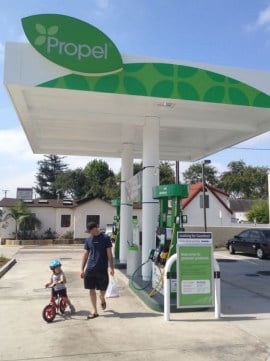
(Photos © J. Maus/BikePortland)
I recently returned from a quick trip to Fullerton, California to help my brother celebrate his 40th birthday. Given that I’m from Portland, a place known for being, you know, all sustainable and stuff, my brother wanted to show me this cool new gas station that had just opened up near his house.
When my brother’s new Lexus CT Hybrid was nearly empty, we pulled into Propel. I could instantly tell it was a different kind of gas station. Not only do they have warm and fuzzy marketing banners that say things like, “I choose a healthier future for kids”; pumps that dispense all sorts of fuel concoctions like E85 ethanol and biodiesel; and the ability to offset your carbon footprint right at the pump as you fill up; they also have a sweet little spot for bikes…
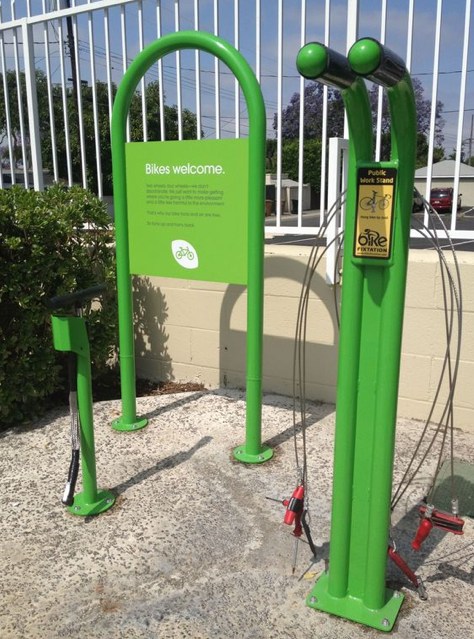
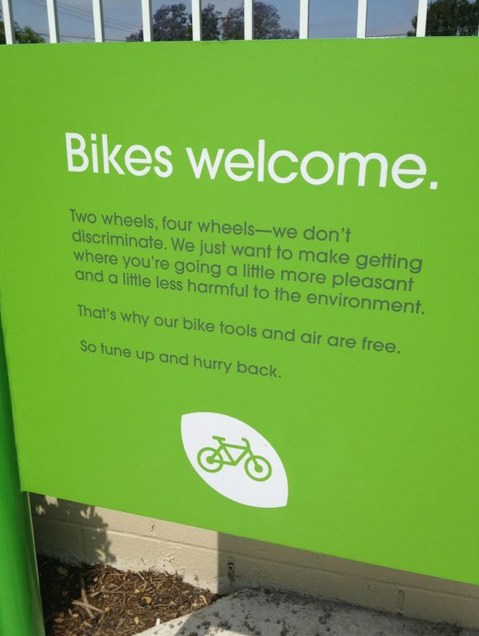
There’s an interesting thing going on in the auto world. While some people simply don’t care about the consequences of car over-use, others are feeling more and more guilty about it. Not everyone can afford (or even wants) a full electric hybrid and of course in most U.S. cities and suburbs, bikes are not considered a viable option. Propel is a business that plays to that second crowd. It exists in part to soften the tricky mix of feelings that comes with daily fuel consumption.
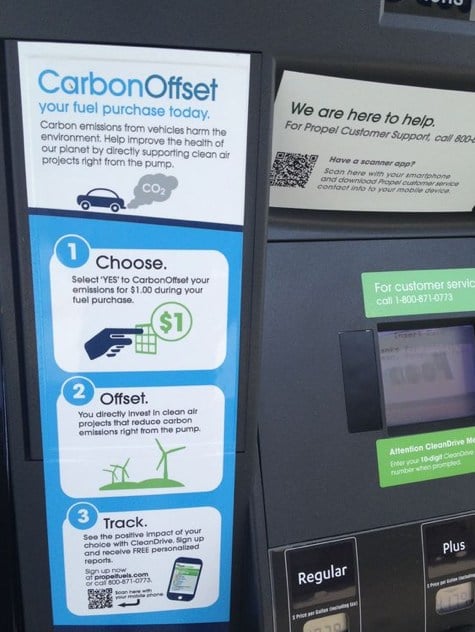

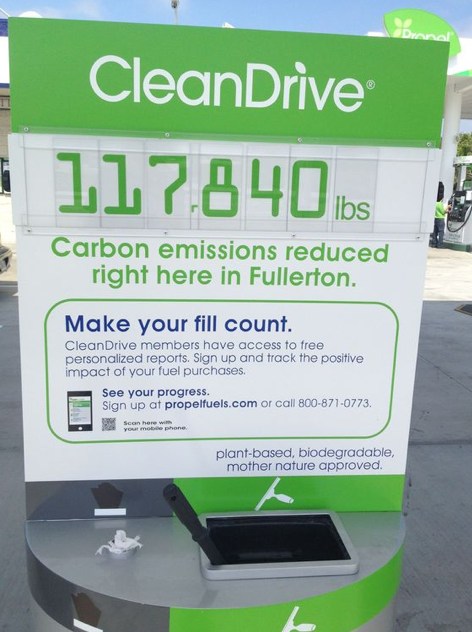
The fact that they’ve given some real attention to bicycles (and yes, the tools and pump are free) and they are doing things a bit differently, shows that at least their heads are in a better place than other stations.
There are five Propel stations in the Seattle area, but so far, none in Portland.



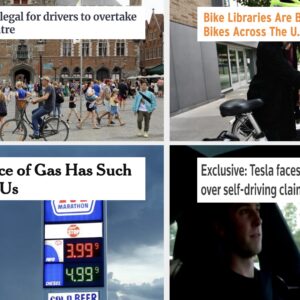


Thanks for reading.
BikePortland has served this community with independent community journalism since 2005. We rely on subscriptions from readers like you to survive. Your financial support is vital in keeping this valuable resource alive and well.
Please subscribe today to strengthen and expand our work.
cool.
“It exists in part to quell the guilty feelings that come with fuel consumption.”
This reminds me a bit of Walmart selling organic produce and using daylighting in their stores to save electricity. Important symbolic steps, but also risky. Walmart displaces local economies, and cars have been doing likewise for many generations. Until we have the big conversation about where we’d like to go in our society, this sort of thing sometimes looks appealing. It’s hard to know what to make of it.
(a) tentative steps away from fossil fuels based economy, or
(b) greenwashing, make-you-feel-better-about-driving
Walmart sells organic produce because their customers ask for it; Walmart daylights their store because it’s probably cheaper than electrically lighting their stores. Also, greenwashing, but if there’s no business case, they don’t do it. They’re still selling cheap garbage imported from China and other countries which effectively is equivalent to offshoring pollution.
Everyone gets on Walmarts case, because they are so much worse than say oh Fred Meyer?
Why does no one complain when a Fred Meyer opens up? They sell electronics, jewellry, clothing, shoes, hardware, household goods, sporting goods, groceries. Don’t they kill local business just as much as Walmart? Don’t they sell the same crap from China as Walmart.
And isn’t Fred Meyer just another company taking their earning out of state, since they are owned by Kroger?
Sure pick on Walmart but be fair handed when handing out criticism of big box stores, throw in Home Depot and Lowes, where are all those small hardware stores now, what about Best Buy, no more small electronics/stereo stores anymore. What about Target moving into the grocery business. New Seasons and Whole Foods, killing off your local green grocer for years now.
Walmart is not worse or better than any of the other stores you all frequent.
wal*mart operates on a scale several orders of magnitude over that of kroger. wal*mart is in a position to dictate not only the wholesale pricing of their suppliers but the very conditions of production. i rarely buy anything at fred meyer, but i have never set foot in a wal*mart.
I’d agree with you except:
1) wal-mart is anti-union and pays the crappiest wages
2) they have forced workers in virtually every state to work while off-the-clock (there was a class action lawsuit against them years ago)
3) they pioneered offshoring
4) they have, for many years, actively censored media distributed through them, such as magazines, where they forced their Christian values across scores of products that were then sold in other retailers
5) they deliberately focused their business model in smaller towns with traditional downtowns that were incapable of competing against the giant, partially through massive government (local, state, federal) subsidies, as well as through dumping and loss-leader (sold below cost) price wars that are also unsustainable. Then they would jack the prices back up after the competition had been cleaned out.
1) wal-mart is anti-union and pays the crappiest wages
— Most big box stores are anti-union including everyone’s favorite New Seasons.
2) they have forced workers in virtually every state to work while off-the-clock (there was a class action lawsuit against them years ago) – –Home Depot sued class action for same issues with working over 8 hour days with out over time in CA
3) they pioneered offshoring – Really, no one else bought foreign manufactered products before Walmart?
–Ever heard of JVC, Japanese Victor Company, a division of RCA.
4) they have, for many years, actively censored media distributed through them, such as magazines, where they forced their Christian values across scores of products that were then sold in other retailers
— What retailer doesn’t censor what they sell. Should Toys R Us sell Hustler? No they get to choose their product line. No one is forced to sell what they don’t agree with.
5) they deliberately focused their business model in smaller towns with traditional downtowns that were incapable of competing against the giant, partially through massive government (local, state, federal) subsidies, as well as through dumping and loss-leader (sold below cost) price wars that are also unsustainable. Then they would jack the prices back up after the competition had been cleaned out.
— And how does Target and Fred Meyer stand up to these same accusations.
But please tell me you don’t shop at store other than locally owned and operated that sell nothing but locally sourced product. None of these stores would succeed without customers.
meh,
this is kind of tedious, don’t you think? Walmart is a scourge on the planet and you feel the need to point out that many other corporations are almost as bad. Well, sure. But what is your point? Your reasoning does not in my view absolve Walmart in any way. I feel no less crummy about the havoc they wreak on local economies, the planet, our future.
Yes, some of us do shop locally exclusively, or try to. There’s also Craigslist for the stuff that isn’t produced locally. I don’t think anyone here was claiming to be perfect, but our imperfections don’t in my view preclude calling out corporations that seem bent on eviscerating local economies.
For the record, I’ve never set foot in a Walmart, Home Depot, Lowes, Costco, Best Buy…. and don’t plan to start now.
Add some EV charging (maybe even Quick Charging) and this place would be da-bomb!
Da-bomb is right — high voltage charging stations discharging static right next to gas pumps.
And what exactly do gasoline pumps run on? Oh right, electricity.
sure but the electricity in the pumps runs through grounded shielded cable directly to the isolated pump motor, as opposed to static electricity which goes where it wants when it wants,… wise-guy.
Are any of you electrical engineers? No?
Enough already. The point I made was that the pumps run just fine on electricity without danger to anyone and probably run on 220 volts. BTW, I have taken a couple of courses in EE or Electrical Engineering.
Last, new car tires often generate a lot of static electricity that can often reach over 100,000 volts. Don’t believe it? Then why do auto parts stores sell ground straps for vehicles just for this purpose?
EV charging stations (or even Quick Charge stations) don’t create any static electricity. The definition of static electricity is an electrical charge built upon a surface until bled off to ground or neutralized by a discharge.
Electric vehicles charge by taking an AC voltage (or DC for Quick Charging), running through a AC to DC converter and charging the battery pack. Most EVs even use isolated battery chargers, eliminating even more risk of any voltage being present outside of the AC input and charger output.
just fyi, your dollar goes to carbonfund.org, which last year pulled in about 2.2 million (down quite a bit from each of the previous two years, but up by an order of magnitude from where they were just a few years ago)
http://dynamodata.fdncenter.org/990_pdf_archive/200/200231609/200231609_200912_990.pdf
and spent about 1.7 million on “developing programs” to create carbon offsets, apparently by buying “carbon offsets,” which of course do not yet technically exist
https://www.capitalresearch.org/2011/12/carbonfund-org-carbon-scheming-gone-wild/
the guy who set this all up, eric carlson, get paid a little over two hundred grand a year to run the show.
but i guess you gotta start somewhere.
There are reputable carbon offset providers. Carbonfund.org is not one of them!
My bicycle provides carbon offsets and I consider it to be very reputable.
Whatever you got to say about the station’s core business and carbon offsets, the bike station is pretty damned cool. They’d get my business on the rare occasions when I need to refill my car.
I see a slick marketing effort but no substantive changes. People are still buying the same amount of gas for the same purpose. In fact maybe more people are buying more gas, if these marketing efforts are successful. (No business sets out to be unsuccessful or drive away customers.)
They’ll invest in something cleaner, but that part’s up to YOU to foot the bill. One dollar please. What projects does that actually go to? And tell me what project is there on earth where spending more money, doing MORE of anything, results in LESS resource use and destruction? A “healthier future for your kids” is a lot simpler than this.
Seems like the same deal as a church. You put a little money in the collection plate, and are absolved of your sins. Same as giving your change to the homeless. So, maybe worth the $1.
Does that pump have a guage on it? I’d be careful with something that isn’t hand operated, there’s a good chance you’ll blow up your wheel, especially if the tube isn’t seated correctly. I wonder, does the place sell tubes and chain lube too? Maybe a tube vending machine would be a nice addition: http://www.rideyourbike.com/vendingmachine.html
It looks like a hand pump to me, with a black “T” handle above the green post bolted to the ground. The post likely contains the air cylinder. Of course it’s still nice to have a gauge even on hand pumps…
yes. it does have a gauge. It’s just a standard Blackburn floor pump, but reinforced inside a steel shell and with a much stronger, aftermarket house and valve.
Free air is good. One thing I really dislike about Oregon is the 50c every time you want to add air to a tire.
I wish every station had free air, right at the pumps. Run around filling your tires as you fill the car with gas.
Les Schwab will fill your tires for free. I guess you can stop in there to save 50 cents. 🙂
Yea, but they lobby to keep studded tires on cars, so I avoid them now.
I remember my first alarm clock. It was a clock, with an alarm. Then they added a radio and the old combo all but disappeared. Then that one broke and I got a new clock radio that had a flashlight built into it.
I wondered what that was all about and then, very soon after my purchase of the flashlight/alarmc lock, that model got all but killed by a new model that had an integrated CD player.
I bet right before I got rid of my flashlight/alarm clock completely and started using my cel phone, I could have found a CD player/alarm clock with a flashlight built in.
This is a gas station with a flashlight built in.
It ain’t perfect, but I’d take my business there in preference to BP, or Chevron or any of the others.
I think I saw another one of these stations near LAX.
As for the bike repair stand – this nifty one is a 2nd generation one made by Dero – Scott at Alta just installed one at their office last week. (Though the air hose is too short.)
I wish air was still 50 cents – more are now 75 cent and up. (You can always as the clerk to turn it on for free – they may do that for cyclists.)
I’m so glad the lady in the picture is choosing “a healthier future for her kids”. When the earth is 4 degrees warmer will be able to show our grandchildren these profound steps we made to be “greener”.
Never mind electing people who will pass IPCC recommendations; these are the kind of free-market solutions that we need.
Keep up the good work California and Seattle! We’re on our way!
Who told you the earth is going to be 4 degrees warmer? Was it Al Gore? The worlds first carbon billionare!
Not that any science will change your mind…ever, but here it is.
http://www.ipcc.ch/publications_and_data/ar4/wg1/en/spmsspm-projections-of.html
Not believing in global warming won’t make it not happen, your just going to contribute more to it.
Actually, its now called “Anthropomorphic Climate Change,” as the earth is naturally going to be warmer with CO2. Not all CO2 is bad, otherwise it would be -250 C outside and there would be no life, just like Mars.
Anyways. “Global Warming” was a poor choice of name because it sounds like its going to get really hot, when some places will get colder.
anthropogenic.
anthropomorphic means something else.
Climate change with a smile…?
Wow, what a sad state that our educational system is in.
This is barely worth my time, but the Greenhouse Effect (which your referring to) is responsible for about 35 degrees of warming. Not 250 (which would make Earth as cold as Pluto). Mars has a atmosphere that is 95% CO2. Made up numbers discredit your argument…I could go on and on.
But once again, This is why Americans don’t elect people who will do anything about Global Warming! (Human induced climate change).
Just kind of wondering… there are 5 of these stations in the Seattle area, but none here. Is it because they do not want to pay for extra labor to have people pump the gas?
To be really decisive you don’t run E85 for a whole host of carbon positive reasons including a roughly 40% drop in fuel economy.
Ethanol as used in Brazil is viable. Excess biomass, non food base converted to straight ethanol and run in ethanol only vehicles works like a champ. But E85 is the worst of both worlds.
But it really is nice to see stations also catering to the non car driver. BTW, be careful using station air pumps to fill bicycle tires. When I worked in a shop they used to blow out bike tire tubes all the time (too much volume).
I’m sorry, but I have to chime in here and say that this post is full of false statements and you should really do some research before making blanket claims about E85.
I do a lot of work around biofuels and energy in my day job and E85 is one of those things that is so widely misunderstood, in no small part due to the campaign of mis-information put out there by the oil lobby.
Is E85 a perfect “planet friendly” fuel? No, it’s not. Are there bad ways to make E85? yes, there are (corn comes to mind…) but there are also good ways to make it that burn A LOT cleaner and use waste products or sub standard crop land. There is a company here in Oregon for example that makes ethanol from fruit waste sugars. I know of another company in California that makes it from switch grass in the off seasons.
The falsehood that really gets to me though is when people make these wild claims that E85 reduces gas mileage. In the tests I’ve done the average reduction in mileage on a Flex Fuel vehicle when switching between E85 and E10 (the standard one gets at the pump in Oregon) is 5%. However, miles per gallon for most people is the wrong question. The true question should be miles per dollar. Economically speaking given that E85 is always cheaper you could get a reduction of 15% in mileage and you would still be ahead from an economic perspective.
Now please, don’t get me wrong, I don’t think biofuels like E85 are perfect and I’m not oblivious to their problems. However, unlike gasoline, they can be produced in a way that is far more sustainable than oil. Much like the utility electric grid, it can be built in an irresponsible way, or a responsible way. Straight up dismissing them however is silly and creates one of those two choice arguments we all seem to love these days (you can only have THIS or THAT!)
As for Propel, I’ve done a bit of research on them and I won’t deny some of what they do is smoke and mirrors to give people that fuzzy happy feeling after they’ve filled up their tank. I would say a much more sustainable fuel company is SeQuential out of Eugene. If you want something like this in Portland that really does sell fuel made in Oregon AND is very frendly to bikes I would write them a letter and encourage them to expand into the Portland area.
Andrew K,
I agree with much of what you wrote, except this:
“The true question should be miles per dollar.”
Miles per gallon, miles per dollar, miles per dead Iraqi are not in my view good metrics of anything we should be striving for. We need to phase out our reliance on fossil fuels, and on biofuels that rely so heavily on inputs that destroy soils, and/or are themselves derived from fossil fuels.
Miles per tortilla seems a better metric to me.
I don’t disagree, however when making a comparision between between fuels many people will label one fuel as better than another (say gasoline is better than E85) because a driver gets better miles per gallon with gasoline. However if gasoline is $5.00/gal and E85 is $3.50/gal is getting and extra 2 miles per gallon on gasoline really the better deal?
Strictly speaking you are correct though. The general public is really far removed from the true cost of just about every fuel out there. Come to think of it, we are pretty far removed from just about everything we buy, from food to electricity to even the computer I’m typing this post on. I am a big believer in more transparency for consumers. Speaking as someone who makes it a point to spend my dollars as ethically as possible I find it scary how difficult it is to find out where the things one buys come from.
I thought the main reason ethanol is cheaper in the US is because it is (even more heavily) subsidized than the stuff we get from Iraq. You know, the Farm Bill…. Or maybe I’m misremembering that?
Ethanol subsidies have expired however corn subsidies still exist. Whether or not those subsidies were ever higher than oil will depend entirely on what source you believe.
In Europe they get around the BS by measuring by grams of CO2/km.
“The falsehood that really gets to me though is when people make these wild claims that E85 reduces gas mileage. In the tests I’ve done the average reduction in mileage on a Flex Fuel vehicle when switching between E85 and E10 (the standard one gets at the pump in Oregon) is 5%.” That can’t possibly be anywhere near true. Ethanol has 40% lower energy content than gasoline. Comparing E85 with E10 the difference will be less than 40%, but still many times the 5% difference that you quote.
That’s why, for flex-fuel vehicles, the EPA gives separate ratings for operating on gasoline vs. operating on E85. They typically indicate a 25-30% reduction in fuel economy with E85. Here are some typical examples:
2012 Ford Focus FFV: 28/31/38mpg on gasoline, 19/22/28mpg on E85.
2012 Chevy Malibu: 22/26/33mpg on gas, 15/18/23mpg on E85.
2012 Chrysler 300: 19/23/31mpg on gas, 14/17/23mpg on E85.
2012 Dodge Charger: 19/23/31mpg on gas, 14/17/23mpg on E85.
2012 Chevy Equinox AWD: 20/23/29mpg on gas, 14/17/20mpg on E85.
2012 Dodge Caravan: 17/20/25mpg on gas, 12/14/18mpg on E85.
2012 Ford F150 4WD FFV: 16/18/21mpg on gas, 12/13/15mpg on E85.
2012 Chevy Tahoe 1500 4WD: 15/17/21mpg on gas, 11/13/16mpg on E85.
You’re right that mpg isn’t apples-to-apples if you’re comparing fuels with different energy content (diesel, for example, gets better mpg than gasoline, but also generates 15% more GHG emissions per gallon than gas). But you’re wrong in claiming that the mpg difference between E10 and E85 is minimal.
And on what universe has the EPA mileage estimates ever been accurate on either end of the scale?
I’ve done the tests myself with a variety of road conditions for a fleet of well over 300 vehicles. On average the reduction was 5%.
keep in mind too that none of the EPA tests are taking into account a vehicle with a variable turbocharger which can change the compression ratio of the engine based on the fuel being used. They are simply dumping a different fuel in a car tuned to work at it’s best with regular gasoline.
Now, this isn’t necessarily wrong considering most people aren’t going to re-tune their engine’s compression ratio every time they switch fuels, but that is not something you can blame on E85, it’s just bad car engineering and a sign that the auto makers never embraced the possibilities behind using alternative fuels. They just simply made the car with a bit more durable fuel lines, and programed the car’s ECU not to trip the “Check Engine Light” when one put E85 in it.
But I’ll stop now. As I stated before, I don’t think E85 is a perfect fuel and I hate myself a little for jumping on here and defending it. It has it’s share of problems (mono cropping in my opinion being the biggest) so I don’t think anyone using E85 should fuel up and drive away thinking they did their good deed for the day.
I just looked it up. Ethanol has 34% less energy per gallon than gasoline, not the 40% I quoted earlier. My bad on that one.
As for EPA tests, I’m somewhat of a fuel economy expert and I’ve seen that the EPA numbers are VERY predictive of fuel economy — in a relative sense. By that I mean that a vehicle rated for 25mpg may get 20mpg with one guy driving it in one set of conditions, or 35mpg with me driving it in the conditions I typically encounter. And if you put the same driver behind the wheel of a 20mpg-rated vehicle in similar conditions, that first guy is probably going to get very close to 16mpg, and the second guy is probably going to get very close to 28mpg in that vehicle.
It’s entirely right that the EPA tests don’t take into account a vehicle with a variable turbocharger or highly variable compression ratio, because as you pointed out NO ONE MAKES SUCH A VEHICLE. In the real world, most people are going to see far lower fuel economy, though maybe marginally higher fuel efficiency, running E85.
I was trying to prevent a statistics and fact fest but:
1. Ethanol contains 20% less energy per gallon
2. I tried E85 driving across country in a minivan that averaged 25 mpg on gasoline (I saw as high as 27). Tried E85 in Nebraska under ideal circumstances: flat, level, straight, and non stop.
3. Average MPG gasoline = 25 mpg; MPG E85 = 16; That’s a 36% drop in mpg in one tank. If you go by the 27 mpg I had just been getting that’s a 40% drop.
4. Fueled up with E10: right back to 25 mpg – in the hilly western part of Nebraska.
These are facts Andrew. None of them are faked.
Here’s the reason E85 doesn’t work:
1. Octane: regular gasoline = 87; ethanol = 100
2. To get the most out of ethanol you *need* a compression ratio of about 12:1 (12 to 1) which ethanol can do quite safely but not E85 engines.
3. Your typical gasoline engine that runs on regular has a compression ratio of about 9:1 which will not get the most energy out of the ethanol.
4. Unless you can magically change the size of the final compressed volume in an engine you cannot change the compression ratio. That means an additional drop in fuel economy of about 16 to 20% over the 20% less energy per gallon. Do the math. That’s a 36 – 40% drop in fuel economy.
5. E85 is heavily subsidized due to the corn lobby. It is on average 20% less per gallon than gasoline thanks to our tax dollars. But even at that lower price it is still more costly than regular gasoline once real world fuel economy is factored in.
I reiterate: biomass generated ethanol is quite viable if it does not take away from food crops and doesn’t take massive amounts of petroleum to make. Clearly Brazil can do it. Clearly ethanol works great as a fuel as evidenced by the Indy Racing League which runs on ethanol. E85 is just not viable though.
I’m not an automotive engineer but I read enough of Andrew’s response to understand that a turbocharger (which increases compression) can be used to alter the compression ratio of the engine on the fly based on the fuel provided. The automotive industry hasn’t exactly embraced E85 or made modifications to their vehicles in order to use it most efficiently, so stock vehicles (which the EPA used in its figures) do not provide accurate numbers on what the fuel efficiency of E85 _can_be. According to Andrew, once you use the special turbocharger to optimize your engine for E85, the real difference in efficiency is only about 5% compared to an engine optimized for E10.
IMO though, instead of arguing over grains of sand, let’s ask why it is that the ’83 Honda CRX i had in high school got better gas mileage than any of the cars listed above, including the Ford Focus. It’s been almost 30 years and the auto industry hasn’t been able to make progress in engineering that would let a vehicle attain even close to 100 mpg? Either there’s some motivation not to, or the technology is really that stale and outdated. WTF?
“Either there’s some motivation not to, or the technology is really that stale and outdated.”
yep.
VW produced a 235 mpg diesel car but never manufactured it. They did manufacture an 80mpg four seater (Lupo) for a while.
But I’m done chasing those statistics. It doesn’t matter any more whether we build cars that get 20 or 100 mpg. We have to leave the fuel in the ground. There’s really no argument I’ve seen that suggests we can afford to burn any more of the stuff.
Your crx would never pass today’s stringent emissions laws. Lean burn engines increase nitrogen oxides.
most Space Age gas stations have a free hose, no gauge though. Uses schraeder and your thumb
I was struck with Jonathan’s statement:
“There’s an interesting thing going on in the auto world. While some people simply don’t care about the consequences of car over-use, others are feeling more and more guilty about it.”
The gas station fits in with a lot of trends over the last 4 years or so:
…SUVs with green bumper badges touting pointless feel-good technologies like hybrid power, “partial zero emissions,” flex-fuel, etc.
…car ads that directly position their products against transit, biking, walking instead of of other cars.
…the transparently inflated rhetoric of “cars vs. bikes,” coming mainly from print media heavily dependent on auto ads
…auto industry reports about “smart cars” or other foofraw intended to appeal to young people who are more interested in iPhones than cars
None of which suggest to me an industry confident about its future. It feels like the stereotype is becoming “cars are for old-fashioned people who live in the past.”
You hit many nails on the head, Paul.
Which is another reason I’m suspicious of the City Club’s project to do a comprehensive study of bicycling. http://tinyurl.com/bndeug3
Has anyone been to SEQUENTIAL down in Eugene? They have a crazy gas station similar, but better, to this. Theirs has solar panels on the roof!
http://www.sqbiofuels.com/retail
There are a lot of tuners who love e85 since it burns cooler to make ridiculous boost levels in turbocharged cars safer and cheaper than gasoline. It’s difficult to notch up the boost pressure on gas without detonating the engine but can be cranked up almost blindly with e85 to make big power. Who would have thought the racers would benefit the most.
How about an ebike charging station? We use 4 cents in electricity to save a gallon in gas, as an ebike can replace a car much more realistically than a normal bike. Note: I’ve been road cyclist for 14 years, still am.
Here’s an article from Business Week with more information about Propel Fuels.
http://www.businessweek.com/articles/2012-06-01/the-gas-station-of-the-future-just-opened?r=read